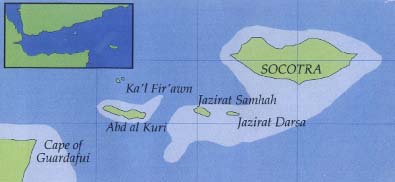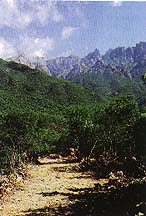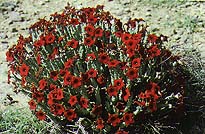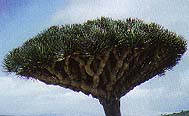ISLAND OF DRAGONS SOCOTRA
Text and pictures by Wolfgang Wranik
 "Dioscorida
is very large but desert and marshy, having rivers in it and crocodiles
and many snakes and great lizards, of which the flesh is eaten and the
fat melted and used instead of olive oil" - thus commented the author of the Periplus of the Erythraean Sea, a shipping manual written by an unknown Greek sailor in the first century AD. The island that he was describing was Socotra which today forms part of the Republic of Yemen and was, towards the end of 1993, the subject of a UNESCO fact-finding mission to consider the establishment of this unique island as a Biosphere Reserve.
"Dioscorida
is very large but desert and marshy, having rivers in it and crocodiles
and many snakes and great lizards, of which the flesh is eaten and the
fat melted and used instead of olive oil" - thus commented the author of the Periplus of the Erythraean Sea, a shipping manual written by an unknown Greek sailor in the first century AD. The island that he was describing was Socotra which today forms part of the Republic of Yemen and was, towards the end of 1993, the subject of a UNESCO fact-finding mission to consider the establishment of this unique island as a Biosphere Reserve.
 Apart from some 19th century travel accounts and a few more recent expeditions, including a British joint-services and civilian expedition in 1967 (see Socotra: Island of Tranquillity, by Brian Doe, published by Immel Publishing, 1992) the Socotra archipelago has received relatively little attention from the scientific community, being virtually isolated from the rest of the world and effectively closed to foreign visitors for the last quarter century or so by a combination of military considerations and extreme natural conditions. The south-west monsoon, which kicks up high seas in the area from April to October, has created a physical barrier to access since earliest times. Even during the calmer periods landing there may still be difficult due to a combination of logistical problems, including the absence of adequate harbour facilities.
Apart from some 19th century travel accounts and a few more recent expeditions, including a British joint-services and civilian expedition in 1967 (see Socotra: Island of Tranquillity, by Brian Doe, published by Immel Publishing, 1992) the Socotra archipelago has received relatively little attention from the scientific community, being virtually isolated from the rest of the world and effectively closed to foreign visitors for the last quarter century or so by a combination of military considerations and extreme natural conditions. The south-west monsoon, which kicks up high seas in the area from April to October, has created a physical barrier to access since earliest times. Even during the calmer periods landing there may still be difficult due to a combination of logistical problems, including the absence of adequate harbour facilities.
The crocodiles and giant lizards referred to by the author of the Periplus are no longer present there today. No fossils have so far been discovered but this is not to say that they did not exist. Indeed, the Indian Ocean crocodile survived right up to the 17th century AD when it was described by sailors visiting the Seychelles, which lie 1,600 kms due south. Such lost inhabitants apart however, Socotra remains, from a natural history viewpoint, one of the most fascinating places in the world. Its unique character is the result of a long period of isolation - its separation from Africa is believed to have occurred in the mid-Pliocene (approx six million years ago). As a result, many animals and plants that live today on Socotra are found nowhere else on earth. The very high degree of endemism is what makes Socotra such an important place in terms of global wildlife conservation. It is believed that some of the plants and animals found on Socotra are in fact ancient relicts of a much larger land mass which have been preserved here as a result of the fact that the Haghir massif has not been totally submerged for at least 135 million years. The absence of any indigenous mammals is further indication of the island's very ancient origins, presumably from a time before mammals appeared on earth.
 The island itself measures approximately 120 kms long by 40 kms wide and covers a total area of 3625 sq kms. It is composed of a basement complex of igneous and metamorphic rocks of pre-Cambrian age (4,500 million years ago), overlain by sedimentary rocks, mainly limestone and sandstone. Topographically it can be divided into three main zones: the coastal plains, a limestone plateau and the Haghir mountains. The island is sparsely vegetated and dominated by xeromorphic (drought resistant) forms which are well adapted to the harsh conditions, including the dessicating effects of sun and wind. Only in sheltered valleys and higher mountain areas is the vegetation more luxuriant. Open deciduous shrubland of the coastal plains and low inland hills is dominated by the common shrub Croton socotranus and the bizarre tree succulents, the desert rose, Adenium obesum socotranum, and the cucumber tree, Dendrosicyos socotranus. Higher altitudes are home of a variety of frankincense trees, three endemic Socotran aloes (primarily Aloe perryi), and wild pomegranate. One of the most famous botanical curiosities of Socotra is the dragon's blood tree (Dracaena cinnabari) which is restricted to the zones of submontane thicket and montane grassland. The tree is so named because any injury to the bark results in a deep red liquid exuding from the scar - compared in the past to the "blood of dragons".
The island itself measures approximately 120 kms long by 40 kms wide and covers a total area of 3625 sq kms. It is composed of a basement complex of igneous and metamorphic rocks of pre-Cambrian age (4,500 million years ago), overlain by sedimentary rocks, mainly limestone and sandstone. Topographically it can be divided into three main zones: the coastal plains, a limestone plateau and the Haghir mountains. The island is sparsely vegetated and dominated by xeromorphic (drought resistant) forms which are well adapted to the harsh conditions, including the dessicating effects of sun and wind. Only in sheltered valleys and higher mountain areas is the vegetation more luxuriant. Open deciduous shrubland of the coastal plains and low inland hills is dominated by the common shrub Croton socotranus and the bizarre tree succulents, the desert rose, Adenium obesum socotranum, and the cucumber tree, Dendrosicyos socotranus. Higher altitudes are home of a variety of frankincense trees, three endemic Socotran aloes (primarily Aloe perryi), and wild pomegranate. One of the most famous botanical curiosities of Socotra is the dragon's blood tree (Dracaena cinnabari) which is restricted to the zones of submontane thicket and montane grassland. The tree is so named because any injury to the bark results in a deep red liquid exuding from the scar - compared in the past to the "blood of dragons".
 To date, 815 vascular plants have been recorded from Socotra, of which between 230 and 260 are found nowhere else (i.e. endemic species). The least studied groups are the lichens, bryophytes and fungi. The people living on Socotra, especially the bedouins, have a thorough knowledge of the flora and many of the plants have traditional uses, such as providing livestock fodder, fuel, building materials, foods, gums, or resins. Plant extracts are still used in medicines, cosmetic and hygiene preparations, in the manufacture of cordage, as a source of insecticide and in tanning and dyeing.
To date, 815 vascular plants have been recorded from Socotra, of which between 230 and 260 are found nowhere else (i.e. endemic species). The least studied groups are the lichens, bryophytes and fungi. The people living on Socotra, especially the bedouins, have a thorough knowledge of the flora and many of the plants have traditional uses, such as providing livestock fodder, fuel, building materials, foods, gums, or resins. Plant extracts are still used in medicines, cosmetic and hygiene preparations, in the manufacture of cordage, as a source of insecticide and in tanning and dyeing.
Socotra's fauna is just as fascinating. Among the land birds at least four species, as well as 14 sub-species, are restricted to Socotra. More work is still needed to clarify the status of other species. The reptilian fauna is also very rich with 19 out of a total of 22 species regarded as endemics. Sea-turtles also nest on the north-east of the island but there is a need for more work on these (as with almost all Socotra's wildlife). An endemic fresh-water crab, Potamon socotrensis, is common in the temporary water-courses. In general the fresh-water habitats of the island have been little studied and it is still not clear whether there are endemic freshwater fish living there. Among the insects it is not surprising to find many forms with reduced wings, lessening the likelihood that they are blown off the island.
From a biogeographic perspective, Socotra is more closely linked with Africa than Arabia but there are also interesting affinities with other island groups such as the granitic Seychelles and even some remote islands of the Atlantic Ocean. There remains a great need for further studies of individual species and of main habitats on Socotra. To date, for example, there has been very little work done on the southern and western plateau, the more isolated granitic pinnacles, as well as the major part of the islands' coastal waters.
Its unique character makes Socotra a potential candidate for designation as either a natural World Heritage Site or a MAB Biosphere Reserve. In practice however what matters is the effect on the ground. A general designation of island-wide protective status would cause problems locally and would not address the challenge of achieving sustainable development. There is little doubt that potential revenue sources for the local population must be developed and these may include small-scale tourism, the cultivation and export of native plants, or the collection and storage of seeds and cuttings for propagation as part of international programmes. Among the steps that could assist this process would be the establishment of a permanent research station at Hadibo, connected with a plant nursery and arboretum.
Given the social and developmental pressures which are now a fact of life on Socotra the continued survival of many endemic species, and of unique habitats is at risk. Socotra provides both an opportunity and a challenge for mankind. Fortunately the concept and value of conservation is still high on the agenda of the island's people. It is to be hoped that local and national efforts to protect Socotra's unique wildlife are supported by international assistance and that the island's uniqueness is maintained for the benefit and pleasure of future generations.
Contents | News | Book Reviews | Back Issues
Forum |
Subjects |
Search | Current Issue | Subscribe
Arabian Wildlife. Volume 2, Number 1